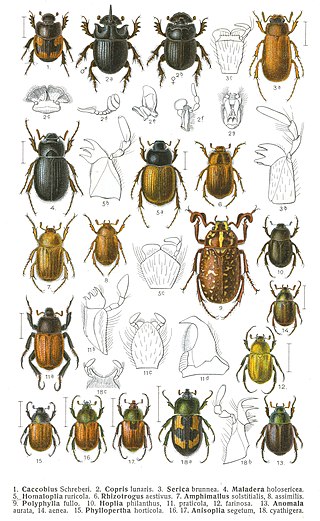
The family Scarabaeidae, as currently defined, consists of over 35,000 species of beetles worldwide; they are often called scarabs or scarab beetles. The classification of this family has undergone significant change. Several groups formerly treated as subfamilies have been elevated to family rank, and some reduced to lower ranks. The subfamilies listed in this article are in accordance with those in Catalog of Life (2023).
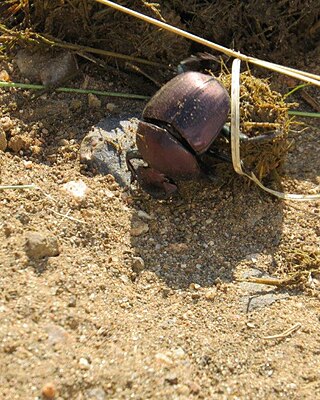
Kheper is a subgenus of Scarabaeus: the typical genus of scarab beetles in the tribe Scarabaeini. The genus name honors the god Khepri in the ancient Egyptian religion, who is depicted as having a scarab for a head. Kheper can be found on the border between Botswana, Namibia, and South Africa in the arid sand dunes. This genus of scarab beetles share a family with the oldest and most revered scarab beetles, the Scarabaeus sacer.

Dung beetles are beetles that feed on feces. Some species of dung beetles can bury dung 250 times their own mass in one night.

Scarabaeoidea is a superfamily of beetles, the only subgroup of the infraorder Scarabaeiformia. Around 35,000 species are placed in this superfamily and some 200 new species are described each year. Its constituent families are also undergoing revision presently, and the family list below is only preliminary. This superfamily includes some of the largest beetles extant today, including rhinoceros beetles, (Dynastinae), the Hercules beetle and Goliath beetles.

Aphodiinae is a subfamily of the scarab beetle family, Scarabaeidae. Members of this subfamily are known commonly as the small dung beetles and many, but not all, are dung beetles. These beetles are found worldwide.

The Trichiini are a tribe of the scarab beetle family (Scarabaeidae), though historically they were often classified as a subfamily, Trichiinae. In Europe, the conspicuous bee beetles (Trichius) are probably the best-known genus of the tribe.
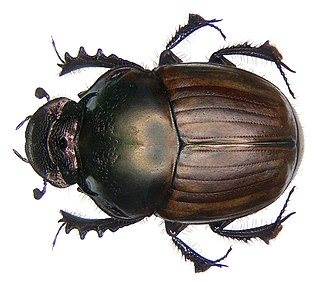
Digitonthophagus is a genus of Scarabaeidae or scarab beetles in the superfamily Scarabaeoidea. It was considered a subgenus of Onthophagus by some authorities. A review of the taxon was published in 2017.

Pericoptus truncatus is a large sand scarab beetle. It is native to New Zealand and is found on beaches throughout New Zealand. Its Māori name is ngungutawa.
Pericoptus frontalis is a sand scarab native to New Zealand which inhabits sandy river banks and sandbars in inland Otago. It was first described by Thomas Broun in 1904. The European hedgehog is a predator of P. frontalis.

Pericoptus punctatus is a sand scarab beetle that is endemic to New Zealand. It is a smaller and similar New Zealand scarab beetle species to Pericoptus truncatus.

Heliocopris is a genus of Scarabaeidae or scarab beetles in the superfamily Scarabaeoidea. Forty-seven of the fifty-two known species are found in Africa, but a few are found in southern and southeast Asia.

Digitonthophagus gazella is a species of scarab beetle. It belongs to the genus Digitonthophagus, which was promoted from subgenus to genus level in 1959. There has been some confusion regarding the application of the names with many people using the outdated name Onthophagus gazella. Dung beetle experts use the term Digitonthophagus gazella.

Aegialiinae is a small subfamily of the family Scarabaeidae. Historically the group has been treated as a tribe within a broad definition of the subfamily Aphodiinae.
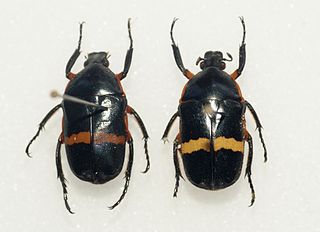
Chondrorrhina is a genus of fruit and flower chafers belonging to the family Scarabaeidae, subfamily Cetoniinae, found in Africa.

Pyronota festiva, commonly known as mānuka beetle or mānuka chafer, is a member of the genus Pyronota of the beetle family Scarabaeidae. It is a scarab beetle endemic to New Zealand, and is commonly found in mānuka trees, hence the beetle's name. In some areas it is considered a pasture pest.

Sulcophanaeus is a genus of dung beetles belonging to the family Scarabaeidae. Most species in this genus are from tropical and subtropical South America, but a few are found in Central America and Mexico, and S. carnifex is from Jamaica. Sulcophanaeus are mostly coprophagous, but some are also necrophagous. They are paracoprids, meaning that adults dig tunnels into the soil under the food source and move parts of the food source to a nest chamber where the eggs are laid, and their activity pattern varies depending on species.

Trichiotinus is a genus of fruit and flower chafers in the family Scarabaeidae. There are about 8 described species in Trichiotinus, all native to the New World.
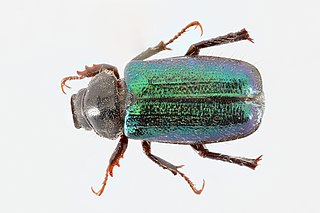
Dichelonyx is a genus of May beetles and junebugs in the family Scarabaeidae. There are at least 30 described species in Dichelonyx.
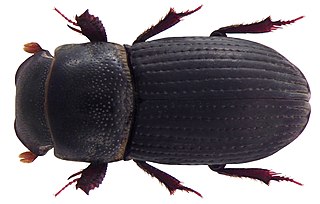
Dialytes is a genus of aphodiine dung beetles in the family Scarabaeidae. There are about five described species in Dialytes.

Trigonopeltastes is a genus of fruit and flower chafers in the beetle family Scarabaeidae, found in North and Central America. There are more than 20 described species in Trigonopeltastes.



















